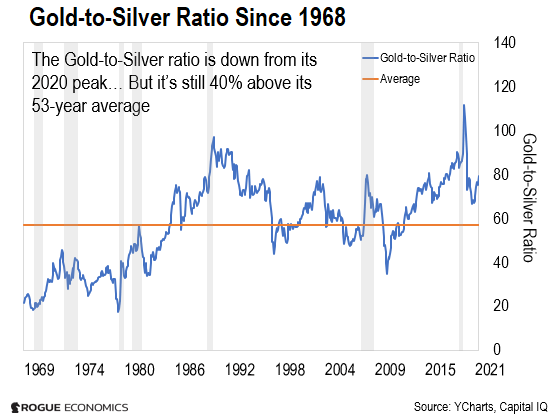If you follow the gold and silver markets, you’ve likely heard of one popular ratio…
The Gold-to-Silver Ratio.
For most people, the Gold-to-Silver ratio is an obscure metric. Even many gold and silver investors struggle to understand it.
So if you’ve always wondered what all the hoopla is about, I’m going to show you how it works.
Then, I’ll give you a simple investment idea you can follow based on what the ratio is telling us today.
Too High? Too Low?
Let’s start with the basics. What is the Gold-to-Silver ratio?
It tracks the price of gold in silver terms. In other words, it tells you how many ounces of silver you can buy with 1 ounce of gold.
Right now, 1 ounce of gold is changing hands for about $1,789. The price of silver is $22.53 an ounce.
So our Gold-to-Silver ratio is at 79. In other words, you need 79 ounces of silver to buy 1 ounce of gold.
Great, but is this expensive or cheap? Let’s look at a chart of the ratio to find out.

The blue line above tracks the Gold-to-Silver ratio. The orange line is the historical average. The grey bars show recessions in the economy.
When the blue line is high, it means silver is cheap relative to gold. When the blue line is low, it means silver is expensive relative to gold.
One thing jumps out from the chart above. And that is the ratio’s most recent peak. In March 2020 (amid the coronavirus crash), the Gold-to-Silver ratio shot up to 112.
That’s the highest it’s ever been. You needed 112 ounces of silver to buy a single ounce of gold.
At 79, the Gold-to-Silver ratio is nowhere near those levels today.
That said, the ratio has been creeping up for the past year, and in recent months, it rose sharply. This puts the current reading at 40% above its 53-year average of 57. That’s high.
The record also shows us that the Gold-to-Silver ratio often surges during recessions or times of financial distress. Again, that’s what the shaded areas on the chart above show us.
But with the ratio 21% down from its March 2020 peak… and with no recession in sight, as colleague Eoin Treacy wrote about here… the economy is nowhere close to that “red flag” territory.
Today’s Implications
As you know, our editor Nomi Prins believes silver is set to go much higher in the coming months.
That’s because silver is both a store of wealth in the distorted environment we’re in… and a key metal in the infrastructure and New Energy megatrends on Nomi’s radar for 2022.
(If you missed my dispatch on the tailwinds from the New Energy megatrend, catch up here.)
And today, the Gold-to-Silver ratio points to higher silver prices, too. The current 79 reading is a bullish sign for silver.
Every time the Gold-to-Silver ratio went above its 53-annual average, it eventually plunged below it. You can see that in the chart above.
That this hasn’t happened in over a decade tells me this may be overdue.
Now, that could mean two things… Either lower gold prices, or higher silver prices.
We think gold is headed higher, so we’ll rule out lower gold prices. This makes the bullish case for silver.
Keep in mind that gold has sold for about 15 times the price of silver through most of U.S. history. If the Gold-to-Silver ratio were to drop to that ratio, say at $2,000 gold, we’d have a $133 silver.
How to Play This Opportunity
In short, we believe silver is going higher this year. So how do you play this opportunity?
Last month, we told you about one of the simplest ways to buy physical silver – coins and bars.
The main drawback of investing in physical silver is that coins and bars are bulky to store.
So, if you’re new to investing in silver, another way to get exposure is through a silver exchange-traded fund (ETF). A silver ETF invests primarily in hard silver assets, and you can buy it through your brokerage account.
We like the Aberdeen Standard Physical Silver Shares ETF (SIVR). The fund stores its metal in London, England, but it’s listed on the New York Stock Exchange.
With no recession in sight, there is plenty of scope for silver to continue to trend higher, as it has done since the start of the year.
Now is the time to add some exposure to your portfolio.
Regards,
Lau Vegys
Contributing Editor, Inside Wall Street with Nomi Prins
Like what you’re reading? Send your thoughts to [email protected].